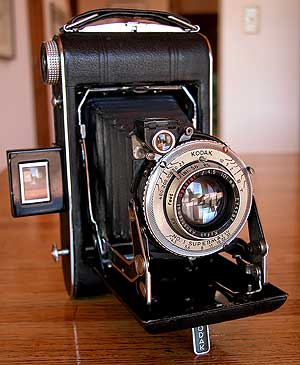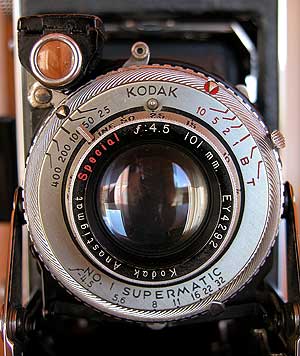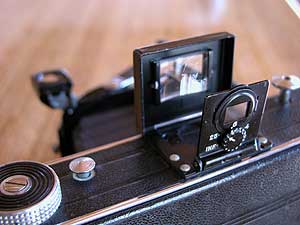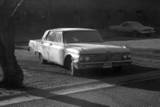Vintage Cameras Home
I found my Kodak Vigilant Six-20 listed on eBay as a "Kodak Supermatic". Perhaps because of the incomplete listing, I ended up as the only bidder at $12.50. There was no real indication of the camera's condition in the listing, but it did not seem like much of a gamble at that price. I knew the Supermatic shutter in these mid-century Kodaks was normally paired with an excellent lens, and that turned out to be the case. Mine has the f-4.5 101mm Anastigmat Special, said to be a Tessar-style design.

Rather than risk some damage, I decided on an arthroscopic-like procedure to get the sticky Supermatic working. I first introduced some Ronsonol lighter fluid on the tip of a small screwdriver blade into the openings in the shutter housing. That only resulted in some slight functional improvement, so I then tried some Radio Shack electronic parts cleaner which comes in a pressurized can with a stiff plastic-bristled brush on the nozzle. After wetting the brush, I introduced a few bristles into the shutter openings and worked them around gently in the mechanism. A few rounds of this interspersed with working the shutter got it clicking nicely at all speeds.(See the pages on the Kodak Monitor and the Kodak 35 for better detail on shutter disassembly.)

The bellows on my Vigilant should really be replaced; typical of the times, it is made of fabric rather than leather, as was the case in older folders. The black coating on the fabric bellows deteriorates with age, resulting in many pinholes appearing through the warp and weave of the material. I solved the problem – at least temporarily – with several applications inside and out of black matte fabric paint obtained from a local craft store. While my last roll through the camera showed the bellows to be light tight, I'm not sure how well it will withstand repeated folding.


Big Rigs – Kodak Tmax 100




PS: John Shriver, Kelly Flanigan and Dave Collopy have provided some additional notes on restoring and using the Vigilant in the Photo.Net Classic Cameras Forum.
Vintage Cameras Home
 © mike connealy
© mike connealy